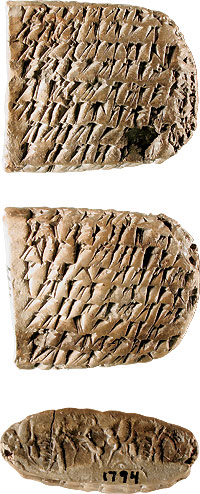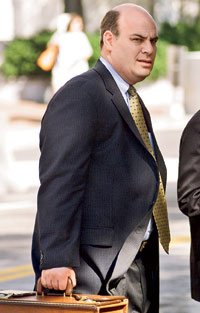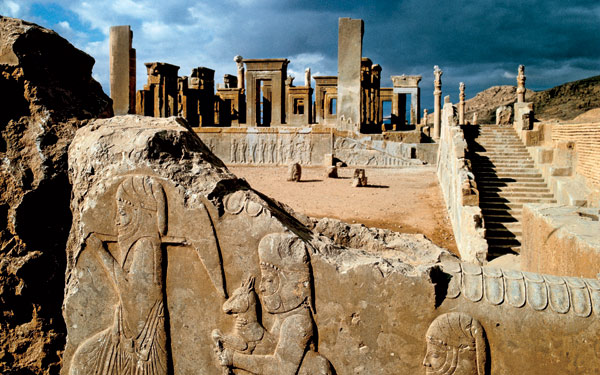
The ruins of Persepolis, situated in what is today southwestern Iran; here, in 1933, laborers discovered ancient clay tablets stored inside a fortification wall.
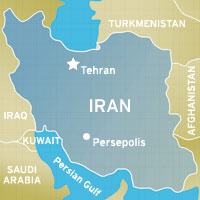 |
In March 1933, an archaeological expedition from the Oriental Institute, a division of the University of Chicago, was working in southwestern Iran among the ruins of Persepolis, the onetime capital of the ancient Persian Empire. While building a road for trucks to bring in drinking water, laborers accidentally uncovered a huge archive of 2,500-year-old clay tablets, inscribed with wedge-shaped cuneiform characters, that had been stored inside a fortification wall.
Five decades later, in October 1983, a terrorist drove a Mercedes truck loaded with explosives into the U.S. marine barracks in Beirut and killed 241 American servicemen. Fourteen years after that, in September 1997, terrorists set off suitcase bombs at Ben Yehuda, a popular pedestrian shopping mall in Jerusalem, killing five people and wounding nearly 200. Claiming that Iran underwrote both bombings, the U.S. survivors and family members of those who were killed sued that country in separate federal lawsuits in Washington, D.C., in 2001. Iran did not make an appearance, and the plaintiffs won a total of more than $3 billion in default judgments.
|
|
Now these disparate elements are coming together in a Chicago courtroom. The plaintiffs in the bombing cases say that the only way they can collect what is owed to them is to force the sale of the Persepolis tablets, currently at the University of Chicago on loan from Iran, and they have filed lawsuits demanding that the archive go on the auction block.
If the plaintiffs succeed, it would be the first time that most of them had received compensation for the injuries and losses they have suffered because they or their loved ones were in the wrong place at the wrong time. Such a ruling, however, could also mean the loss of a cultural treasure that is an irreplaceable window into the past simply because it, too, was in the wrong place at the wrong time.
Whatever the outcome in Chicago, the lawsuits, now before U.S. District Court judge Blanche M. Manning, are expected to wend their way through the appeals process and, in all likelihood, on to the U.S. Supreme Court. And as they do so, they will continue to raise complex and troubling questions about how to weigh the claims of the blameless victims of terrorism against those of equally blameless scholars and museums.
* * *
Photograph: (Image 1) © Aliki Sapountzi/Aliki Image Library/Alamy; (Image 2) Courtesy of the Oriental Institute
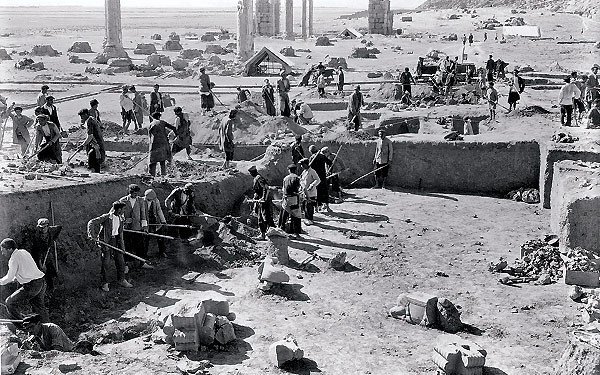
Workers at Persepolis excavate the city during an Oriental Institute expedition in the 1930s.
|
|
The tablets were written during the reign of Darius, the founder of Persepolis and the ruler, from 522 to 485 B.C., of the largest empire the world had known to that time. They range in size from a cocktail olive to a hand towel, and most are written in Elamite, a little-understood ancient language from southwestern Iran. Because translation required specialized knowledge and a research library, neither of which was available in Iran at the time of the discovery, the shah allowed the archive to travel on loan to the Oriental Institute in Chicago. (For the record, my husband, Matthew Stolper, the John A. Wilson Professor of Oriental Studies at the Oriental Institute, currently has the primary responsibility for the analysis and translation of the tablets.)
At the Oriental Institute, the task of working on what came to be known as the Persepolis Fortification Archive fell to Richard Hallock, a scholar of ancient Near Eastern languages who died in 1980. An experienced cryptanalyst—during World War II, he worked for the secret Army Signal Corps program code-named Venona, and he was the first to break the cipher used on encrypted Soviet diplomatic messages—Hallock found decipherment of the Persepolis tablets painfully slow. Starting from scratch and looking for patterns, he spent more than two decades filling dozens of notebooks with color-coded word lists, maps, and diagrams. “If you’re not confused,” he once wrote, “you do not appreciate the problem.”
Worse yet, the individual tablets, essentially parts of an administrative ledger, turned out to be mind-numbingly dull records of the amount of food and drink—for example, an average male laborer would get between 30 and 45 liters of barley a month—given to everyone from the lowest worker to members of the king’s household. However, when Hallock finally published a portion of the archive, in 1969, it shed new light on ancient history. Put together, the banal snippets of information recorded on each tablet provided a detailed picture of how an enormous empire was organized and run. Taking their cue from Greek historians, scholars had long seen the Persian Empire as a loose arrangement of territories overseen by unsophisticated strongmen, but the tablets were firsthand evidence of a complex, highly organized state with a rich cultural legacy of its own.
They were also useful for linguists. “They’re written in a late and sometimes sloppy Elamite that’s mixed with Persian,” said Wouter Henkelman, a postdoctoral researcher at the Free University of Amsterdam who has made an intensive study of the archive. These characteristics, he said, make the tablets a gold mine for scholars interested in how an older indigenous language adapts to a newer arrival.
Photography: Courtesy of the Oriental Institute
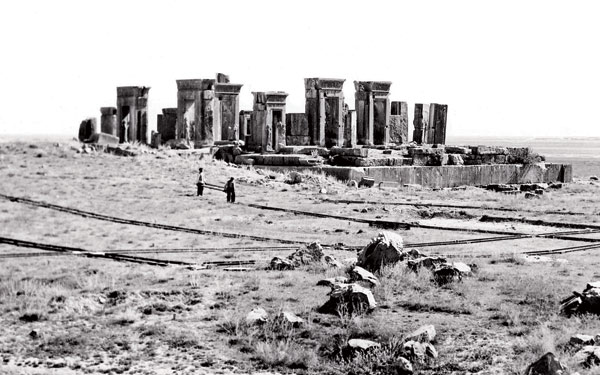
Ruins of the apadana, or great hall, dominate the terrace at Persepolis.
Outside academic circles, the Persepolis archive remained largely unknown—a status that changed abruptly and drastically in the spring of 2004. That’s when David Strachman, an attorney representing the victims of the 1997 bombing in Jerusalem, issued a summons demanding that the Oriental Institute hand over the tablets. A divorce lawyer from Rhode Island, Strachman had made a subspecialty of representing victims of terrorist attacks. By bringing the sharp-elbows style of family court into the ordinarily decorous world of international law, he had been able to rack up a $412-million judgment for the plaintiffs in the Jerusalem lawsuit, known as Jenny Rubin et al. v. the Islamic Republic of Iran (Rubin, a New York fashion designer, was wounded in the Jerusalem bombing). But collecting on the judgment had been a problem, for Strachman had trouble finding Iranian bank accounts or real estate that he could seize and sell. When he learned that the Oriental Institute was studying the Persepolis tablets, Strachman saw an untapped Iranian asset sitting right in Chicago, and he pounced.
Since then, Strachman has set his sights on every item of Persian origin at the Oriental Institute and on the much smaller collection of Persian objects at the Field Museum of Natural History—even though none of the artifacts there are on loan. Arguing that they were stolen from excavations or purchased from crooked antiquities dealers, he claims that they still belong to Iran and thus are subject to being sold for his clients’ benefit.
The Oriental Institute and the Field Museum strongly disagree with Strachman. The items under dispute at the Field, said Joe Brennan, the museum’s general counsel, didn’t come from excavations but from bazaars and from the personal collection of Ernst Herzfeld, the director of the Persepolis expedition at the time the tablets were unearthed. “We think we have good clean title,” Brennan said. “We believe that there should be recourse for people who were victims of suicide bombs, but not out of these collections. Two wrongs don’t make a right.”
* * *
Photograph: Courtesy of the Oriental Institute

The aftermath of the September 1997 suicide bombing at Jerusalem's Ben Yehuda shopping district
Before September 4, 1997, the only link among the eight Americans who came under attack in Jerusalem that day—five teenagers, a chiropractor, a tourist, and a reporter—was their nationality. But on that warm late-summer afternoon, they had another connection—being at Ben Yehuda, where a Burger King, a McDonald’s, and a pizza shop were magnets for visiting Americans—and it would change their lives forever.
A few minutes after three o’clock, three Palestinian terrorists pulled the detonators on bombs that were packed with glass, nails, and corrosive chemicals. The explosion killed the bombers and five Israelis and caused severe burns and other wounds to scores of others, among them the eight U.S. citizens. At an evidentiary hearing in 2003, one of Rubin’s plaintiffs, Avi Elishis, who was 18 at the time of the bombing, testified that when he touched his badly burned face, it felt “like a corn chip.” In the months after the bombing, he underwent multiple operations to remove metal fragments, including a two-inch screw in his spleen and a quarter-inch bolt in his heel, and his body is riddled with scars. “One [screw] is still in me,” he said. “It’s right under my rib, right by my spinal column.”
After the bombing, the Americans said, they were too physically scarred and emotionally traumatized to handle ordinary existence, much less the careers, the incomes, and the personal relationships they had once expected to enjoy. At the 2003 hearing, one man spoke of the insomnia and hypervigilance that had made it impossible for him to relax on a vacation or even sit through a movie. Another talked about chronic facial pain, headaches, and the inability to work a full day, and a third said that he felt so frightened and worthless that he tried to kill himself.
The experience was also devastating for family members who had to watch and care for badly injured loved ones. Another plaintiff, Elana Rozenman, the mother of Noam Rozenman, a junior in high school at the time of the blast, testified that when she first saw her son, he literally looked like toast. “I leaned down to kiss his forehead,” she said, “and his skin came off in my mouth.” After spending months in the hospital with him, listening to him moan in pain and being sent out of the burn unit so that she wouldn’t hear his screams whenever his dressings were changed, she developed such severe stress symptoms that she had to take a year off to recover.
In the past, these plaintiffs would have found little satisfaction in a U.S. courtroom, for under the 1976 Foreign Sovereign Immunity Act, individuals in most instances may not sue sovereign states. The U.S. Anti-Terrorism Act, however, passed by Congress in 1996 and since revised, waives this exemption, known as sovereign immunity, in cases that involve American victims of state-sponsored terrorism. But holders of judgments in such instances can seize and sell only assets involved in commerce. Citing this provision, lawyers for the University of Chicago have argued that, because the Persepolis tablets were research materials and had never been used commercially, they could not be confiscated.
Troubled by the difficulty plaintiffs had in collecting judgments against rogue states, New Jersey senator Frank Lautenberg sponsored an amendment to the Anti-Terrorism Act. Passed by Congress in January 2008, this provision was intended to eliminate the act’s noncommercial exception and made any asset owned by state sponsors of terrorism subject to seizure. (Legal experts are still debating the precise interpretation of the amendment.) Since then, Strachman has refiled his lawsuit to take advantage of this change.
No one expects that the sale of the tablets could bring in a sum close to the Rubin judgment. It’s difficult to estimate the tablets’ dollar value, since only a small number of Persepolis-era cuneiform tablets have appeared on the antiquities market, where the average price has usually been under $500, even for a tablet in prime condition. Perhaps 5,000 to 10,000 of the Persepolis tablets are in good enough shape to fetch a decent price, which means that at best an auction would probably not bring in more than about $2 million to $4 million—and possibly considerably less, given that the release of so many tablets at once would likely drop the unit price.
But the Rubin plaintiffs seem unlikely to get their hands on even this amount. Until recently, they had sole claim to whatever revenues a tablet sale might produce, but they have now been joined by a second set of plaintiffs: the four American survivors of the 1983 Beirut blast and more than 800 family members of the slain marines. It took years for their lawsuit, known as Peterson v. Islamic Republic of Iran, to make its way through the judicial system, but in December 2007, they received a default judgment against Iran of $2.6 billion. Looking to make good on the debt, their attorney, David Cook, studied the Rubin case, and in May 2008 he filed a federal suit in Chicago demanding that his clients get first dibs on any money from the tablets.
* * *
Photography: Reuters/Landov

In 1983, U.S. marines carry a wounded comrade from the rubble of their bombed Beirut barracks.
|
|
The Peterson suit stemmed from an event that took place in October 1983 at the U.S. marine compound in Beirut. It was 6:20 a.m. on a Sunday, the only time off-duty marines were allowed to sleep late, and most were still in their beds as a large pickup truck circled in the parking lot. A handful of guards stood at the entrance, but because the marines were on a peacekeeping mission, they were carrying unloaded weapons. According to one survivor, the man at the wheel of the truck was smiling as he smashed into the four-story building and racked up the highest U.S. marine death toll in a single incident since World War II.
Unlike the Rubin plaintiffs, who had either been wounded themselves or taken care of an injured family member, only four of the Peterson plaintiffs had been under direct attack. But for the parents, wives, children, and siblings of the marines who died in the Beirut bombing, the feelings of devastation and trauma remain vivid and painful.
“I felt like I was going to have a nervous breakdown, like I just wasn’t going to make it,” said Luddie Belmer, a resident of Chicago’s West Side whose oldest son, Alvin, had died from his wounds a week after the attack. A gunnery sergeant, he was 29 and left behind an eight-year-old son. “I don’t know what I can say to the idea that an ancient library is at risk here,” his mother said. “But there were a lot of lives lost and a lot of family tragedies, and if that’s the only way there is to compensate us, that’s just the way it is.”
Annette Livingston, who lives outside Champaign, feels even more strongly about forcing Iran to pay for the attack. She had expected her husband, Joseph, 20 years old and a machine gunner on an M60 tank, to be home in two weeks; instead, she and their 18-month-old son spent the next week waiting for his body to be found. “The only way to stop these people is to take their money, so I say take the artifacts and sell them,” she said. “I’d ask any scholars who have a problem with that whether they have any family members that have been victims of terrorism. If not, they don’t have any right to raise an argument.”
* * *
Photography: (Image 1) AP photo/Hussein Ammar; (Image 2) Courtesy of the Belmer family
|
|
Citing ongoing litigation, David Strachman declined to be interviewed for this article. But at a May hearing on whether to allow the Peterson plaintiffs into the case, he evidently could not contain himself. Having a second group in the case, he told the Sun-Times, was “terrorism victims attacking other victims,” and it was “unseemly for lawyers for one group of victims to undermine collection actions of other victims.” He went even farther in a later motion, where he denounced the Peterson suit as “utterly frivolous.”
David Cook, the Peterson lawyer, is a collections attorney from San Francisco whose Web site is squeezebloodfromturnip.com. Cook started his legal career liquidating businesses and selling grocery stores, and has spent the last decade pursuing O. J. Simpson on behalf of the family of Ron Goldman, the man who was killed in June 1994 along with Simpson’s ex-wife, Nicole. “The Rubin attorneys think I’m a plain old party crasher, that I’m trying to cut in line,” Cook said. “But I don’t think there is a line. My job is to collect for my clients.”
In June, he filed a motion seeking to dismiss the Rubin suit on a technicality (failing to serve Iran with a mailing notice) and take ownership of the archive away from Iran, and calling for a blue-ribbon panel—he suggests that Louis Freeh, the former director of the FBI, be a member—to oversee the sale of the tablets to a museum or university after the Oriental Institute completes its research. Judge Manning quickly denied the motion, but Cook has filed for appeal before the Seventh Circuit and remains hopeful about such an approach.
“It’s a winner,” he said. “Everyone walks away with exactly what they want. We get some dough, the University of Chicago gets to continue its studies, and we unwind the Gordian knot of how to accommodate the scholarly community versus the rights of judgment creditors to get paid.”
It’s not a vision that the University of Chicago shares. “The terrorist acts that led to these judgments against Iran are reprehensible,” said Matt Allison, a partner at Baker & McKenzie, who is acting as outside counsel for the university in this matter. “But the University of Chicago believes these antiquities are immune from attachment, and it will continue to resist the efforts of both the Rubin and the Peterson plaintiffs to seize them.”
Throughout the case, David Strachman has been unwavering in his insistence that the tablets are assets, just like dollar bills or property deeds, and do not deserve any special treatment. “The issue is not really the antiquities,” he told National Public Radio. “This is an issue of, you know, five young people who were in a horrible attack at the prime of their life, as teenagers basically.”
Patty Gerstenblith, director of the Center for Art, Museum and Cultural Heritage Law at DePaul University’s College of Law, sees it differently. “Even with a great deal of sympathy for the victims of both incidents,” she said, “these artifacts aren’t the kind of things that should be sold to satisfy the judgments these claimants have.”
She explained that ordinarily plaintiffs in a civil suit are limited by the ownership interests of the defendant—and because current Iranian law would not permit Iran to sell the tablets, the Rubin and Peterson plaintiffs should be under the same restrictions. But her larger point was that the real value of the tablets is not in the objects themselves but in the cumulative information they provide when looked at together. “If they’re put on the market,” she said, “they’d actually lose their value because they’d be split up and end up on somebody’s mantelpiece instead of being studied.”
If Rubin and Peterson do succeed, she added, it would be the first time that a U.S. court had seized culturally significant items not to return them to their original owner but to pay off a debt of the owner. “We want to encourage international loans,” she said, “but this would discourage that because it would make cultural objects on loan too vulnerable to a claim someone has against another country.”
It would also give the United States a black eye in much of the world, according to Gil Stein, director of the Oriental Institute. “Selling off the cultural heritage of another country would make the U.S. look like barbarians,” he said. “These victims have every right to some sort of justice, but this isn’t the way. This is the justice of a pound of flesh, and that’s not justice at all.”
* * *
Photograph: AP Photo/Victoria Arocho
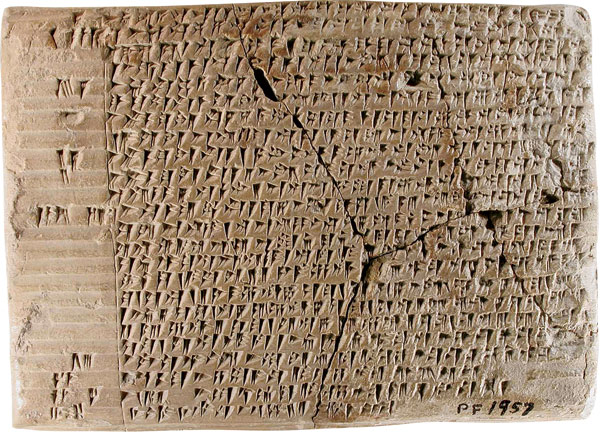
Represented by wedge-shaped cuneiform characters, the language on the tablets is a mixture of what one scholar calls "sloppy Elamite" (a little-understood ancient language) and Persian.
As with any such case, there are plenty of rumors: A Persian Gulf state will buy the archive; the recent financial agreements between the United States and Libya will provide a model for resolving U.S.-Iranian monetary claims; the folks in Washington will do something. More concretely, David Strachman is busy wrestling with Iran over discovery, and David Cook is going after both the fuel oil that British Petroleum and other global giants buy from Iran and the money Iran pays for refined oil on the international market. And, of course, each attorney is still trying to push the other’s lawsuit out of the way.
Despite the lack of resolution, however, the proceedings in Chicago have already made legal history. Presumably because it considered lawsuits brought under U.S. law to be illegitimate—and also because it seemingly had no assets that could be attached—Iran had long declined to appear in U.S. courts and contest the many suits filed against it. But in the proceedings related to the Persepolis tablets, it has for the first time sent attorneys to represent its interests—and, in an equally unprecedented move, the Bush administration has actually weighed in on the side of its nemesis. Apprehensive about repercussions from selling off what Stein, the Oriental lnstitute’s director, has characterized as “the Magna Carta of Iran,” the Bush Justice Department has filed three separate statements that effectively favor allowing Iran to keep the tablets. Not surprisingly, Strachman has criticized this step, telling the Washington Post that the government is “blatantly opposing us.”
But for Laina Lopez, a lawyer at Berliner, Corcoran & Rowe, the Washington, D.C., firm representing Iran before Judge Manning, the problem is that the U.S. government’s support for letting Iran hold on to the artifacts doesn’t seem to matter. “From Iran’s point of view,” she said, “the Justice Department’s should be respected and deferred to, but that’s not what’s happened.”
Given all the legal wrangling, the fight over these centuries-old tablets may take years to resolve, no matter how the U.S. government weighs in on the dispute. Meanwhile, the Oriental Institute, the Field Museum, Iran, and more than 800 people who have suffered from terrorist attacks remain at loggerheads.
Photograph: Courtesy of the Oriental Institute



